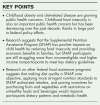Supplemental Nutrition Assistance Program as a health intervention
- PMID: 36354297
- PMCID: PMC9803386
- DOI: 10.1097/MOP.0000000000001192
Supplemental Nutrition Assistance Program as a health intervention
Abstract
Purpose of review: In 2020, obesity prevalence among US children reached 19.7%, impacting about 14.7 million children and adolescents. Food insecurity among children is also a public health concern but has largely decreased or remained stable over the past decade, reaching 6.2% of US households with children in 2021. Given food insecurity and obesity's interconnected nature and their negative consequences on children's health, it is of interest to assess the Supplemental Nutrition Assistance Program's (SNAP's) impact on childhood food security, dietary quality, disease risk, and health outcomes.
Recent findings: Evidence suggests that SNAP participants, including children, struggle to meet key dietary guidelines and perform poorly on key health indicators when compared with income-eligible and higher income nonparticipants. Children participating in SNAP were more likely to have elevated disease risk and consume more sugar-sweetened beverages (SSBs), more high-fat dairy, and more processed meats than income-eligible nonparticipants. However, research suggests that federal food assistance programs with more stringent nutrition standards - the Special Supplemental Nutrition Program for Women, Infants and Children (WIC) and the National School Lunch Program (NSLP) and School Breakfast Program (SBP) - improve dietary quality, increase birth weight and gestation periods, and reduce childhood obesity, infant mortality and healthcare costs.
Summary: After reviewing the evidence on SNAP's impacts on food insecurity, dietary quality, and health as well as research on the health impacts of other more successful federal food assistance programs, we provide three policy recommendations to strengthen SNAP's effectiveness as a health intervention for children and families.
Copyright © 2022 The Author(s). Published by Wolters Kluwer Health, Inc.
Conflict of interest statement
Similar articles
-
Delivering Summer Electronic Benefit Transfers for Children through the Supplemental Nutrition Assistance Program or the Special Supplemental Nutrition Program for Women, Infants, and Children: Benefit Use and Impacts on Food Security and Foods Consumed.J Acad Nutr Diet. 2017 Mar;117(3):367-375.e2. doi: 10.1016/j.jand.2016.11.002. Epub 2016 Dec 22. J Acad Nutr Diet. 2017. PMID: 28017594
-
Dietary quality of the US child and adolescent population: trends from 1999 to 2012 and associations with the use of federal nutrition assistance programs.Am J Clin Nutr. 2017 Jan;105(1):194-202. doi: 10.3945/ajcn.116.135095. Epub 2016 Nov 23. Am J Clin Nutr. 2017. PMID: 27881390
-
Heat or eat: the Low Income Home Energy Assistance Program and nutritional and health risks among children less than 3 years of age.Pediatrics. 2006 Nov;118(5):e1293-302. doi: 10.1542/peds.2005-2943. Pediatrics. 2006. PMID: 17079530
-
A Historical Review of Changes in Nutrition Standards of USDA Child Meal Programs Relative to Research Findings on the Nutritional Adequacy of Program Meals and the Diet and Nutritional Health of Participants: Implications for Future Research and the Summer Food Service Program.Nutrients. 2015 Dec 4;7(12):10145-67. doi: 10.3390/nu7125523. Nutrients. 2015. PMID: 26690207 Free PMC article. Review.
-
Nutrition Assistance Programs: Cause or Solution to Obesity.Curr Obes Rep. 2016 Jun;5(2):176-83. doi: 10.1007/s13679-016-0207-x. Curr Obes Rep. 2016. PMID: 27033876 Review.
Cited by
-
Investigation of the Link Between Food Assistance Programs and Physical Activity Among Children and Adolescents.J Res Health Sci. 2024 Sep 30;24(4):e00627. doi: 10.34172/jrhs.2024.162. Epub 2024 Sep 30. J Res Health Sci. 2024. PMID: 39431652 Free PMC article.
-
Qualitative Analysis of a Home-Delivered Produce Prescription Intervention to Improve Food and Nutrition Security.Nutrients. 2024 Nov 23;16(23):4010. doi: 10.3390/nu16234010. Nutrients. 2024. PMID: 39683404 Free PMC article.
-
Investigating the Poverty-Reducing Effects of SNAP on Non-nutritional Family Outcomes: A Scoping Review.Matern Child Health J. 2024 Mar;28(3):438-469. doi: 10.1007/s10995-024-03898-3. Epub 2024 Feb 19. Matern Child Health J. 2024. PMID: 38372834 Free PMC article.
-
"It makes you feel worthless." The lived experience of discrimination in the US food assistance system.Soc Sci Med. 2025 May;372:117959. doi: 10.1016/j.socscimed.2025.117959. Epub 2025 Mar 13. Soc Sci Med. 2025. PMID: 40117889
-
Trends in Recurring and Chronic Food Insecurity Among US Families With Older Adults.JAMA Health Forum. 2024 Mar 1;5(3):e235463. doi: 10.1001/jamahealthforum.2023.5463. JAMA Health Forum. 2024. PMID: 38427343 Free PMC article.
References
-
- Bryan S, Afful J, Carroll MD, et al. NHSR 158. National Health and Nutrition Examination Survey 2017–March 2020 Pre-pandemic Data Files. Hyattsville, MD, 2021.
-
This report presents prevalence estimates for child and adult obesity from the NHANES from 2017 to March 2020.
-
- Centers for Disease Control and Prevention. Adult Obesity Facts | Overweight & Obesity. Available at: https://www.cdc.gov/obesity/data/adult.html. [Accessed 02 September 2022]
-
- O’Hearn M, Liu J, Cudhea F, et al. . Coronavirus disease 2019 hospitalizations attributable to cardiometabolic conditions in the United States: a comparative risk assessment analysis. J Am Heart Assoc 2021; 10:1–27. - PMC - PubMed
-
This study estimates the absolute and proportional COVID-19 hospitalizations in US adults attributable to four major US cardiometabolic conditions, separately and jointly, and by race/ethnicity, age, and sex.
Publication types
MeSH terms
LinkOut - more resources
Full Text Sources
Medical
Research Materials
Miscellaneous


